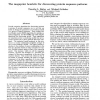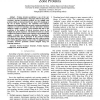393 search results - page 45 / 79 » Multiple Alignment of protein structures and sequences for V... |
ISMB
1996
13 years 9 months ago
1996
Several computeralgorithms for discovering patterns in groups of protein sequences are in use that are basedon fitting the parametersof a statistical model to a group of related s...
BMCBI
2011
13 years 2 months ago
2011
Background: Remote homology detection is a hard computational problem. Most approaches have trained computational models by using either full protein sequences or multiple sequenc...
CIBCB
2006
IEEE
14 years 1 months ago
2006
IEEE
– Protein structure prediction is one of the core research areas in bioinformatics. This paper addresses the protein secondary structure prediction problem for the twilight zone ...
BMCBI
2007
13 years 7 months ago
2007
Background: The rapid burgeoning of available protein data makes the use of clustering within families of proteins increasingly important. The challenge is to identify subfamilies...
ICNSC
2008
IEEE
14 years 2 months ago
2008
IEEE
— This paper presents an approach to the multiple sequence alignment (MSA) problem by applying genetic algorithms with a reserve selection mechanism. MSA is one of the most funda...


